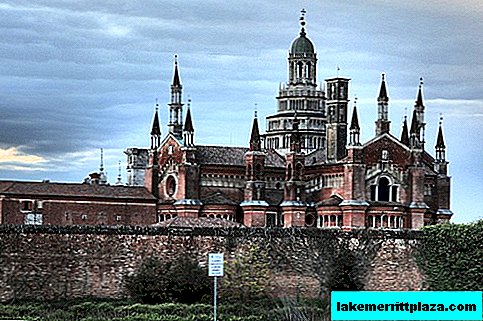"Robiola!" - the Italian will proudly say. "Did not hear ..." - scratching his head, the Russian will answer. And it will not be surprising. Robiola (Robiola) - a soft cheese, not too common among ordinary domestic consumers. Non progredi est regredi, our dear readers. And so as not to hit the face in front of our Italian brothers on occasion, let's plunge briefly into the world of complete information about this overseas product.

Production history
The history of the manufacture of robiola cheese has very ancient roots. It was first produced in the Celtic era in the province of Langhe. Later Pliny the Elder in the 1st century A.D., and then Pantaleone (III-IV centuries) gave a high assessment of the quality of this product.

There are two versions of the name cheese:
- According to most historians, its roots lie in the Latin language. The Celts called it rubeus, which means "ruby," because the crust acquired a reddish tint during ripening;
- According to other sources, it was named after the Italian city of Robbio Lomellina, where it was first manufactured.
The manuscript of the priest Pistone from 1899 describes the history of robiola from 960 to 1860. Among all the historical information, there is one fact of honoring this cheese for many decades. This is evidenced by the fact that Roccaverano (Piedmont) hosted five annual Robiola fairs. The best cheese was exported. Already in those distant times, she conquered gourmets not only in Italy, but also in France.
Vittorio Emanuel II of Savoy - the king of the Sardinian kingdom loved to hunt in the southern regions of Lange (Le Langhe). But especially His Highness liked to stop at the farms to taste the robiola cheese among the peasants.
On July 2, 1996, Robiola di Roccaverano cheese was included in the list of products with a protected name by origin (DOP).
Territory and production technology
Cheese is produced in many provinces of Italy, but only the manufacture of DOP robiola is legally regulated. It is made throughout the year in two provinces of Piedmont (Piemonte): Asti (Asti) and Alessandria (Alessandria).
This is the only cheese in the DOP category made from goat milk taken from certain breeds of animals (Roccaverano, Camosciata Alpina). It is allowed to add milk from cows and sheep (Piemontese and Bruno Alpina breeds), but not more than 50% of the total mass. But some farmers still continue to produce cheese according to a centuries-old tradition, using only goat milk. Animals feed exclusively on pastures, and in the cold season - mowed hay. The use of GMO feed is unacceptable.
It is strictly forbidden to use pigments, dyes and flavorings at all stages of production. For curing, milk cultures of lactic acid bacteria and rennet of animal origin are added to the milk and left alone for 8-36 hours (depending on environmental conditions).
The curd clot is cut into pieces and carefully placed in a perforated mold for draining whey. The process takes about 48 hours. At this time, the molds are periodically turned over to maximize draining of excess liquid.
At the end of the molding process, dry salting is performed and the cheese is sent to special rooms with a temperature of 15-20 degrees for ripening.

From the fourth day of aging, the sale of fresh cheese is allowed. By the 10th day, the taste of robiola becomes more refined, on the 30th day it reaches maximum dryness.
Robiola is available in the form of cylinders with a diameter of 10-13 cm and a height of 2-4 cm. The weight of such a head is from 200 to 400 g.
- In fresh 4-day cheese, the crust is white or absent, the mass is soft ivory.
- Cheese, aged 10 days, firm, straw yellow or slightly reddish, covered with a slight coating of white mold.
- Mature - has a brownish-red dry surface, the body is pale yellow and harder.
How to eat and what to replace robiola in recipes
The taste of fresh robiola is tender, milky, has a slight acidity and notes of nuts and meadow herbs. Aged - has a more intense and spicy aroma. It should be noted that the taste of cheese depends on the type of milk used for its preparation.

For those who love cooking, robiola is a constant source of inspiration and creativity. It is suitable for both hot and cold dishes.
Cheese can be consumed alone with marmalade, ginger, fresh fruits, nuts and raisins, or mixed with green onions, spread on bread. In order to make the taste brighter, it is poured with honey or sprinkled with mustard seeds.
Robiola can be served together with cold cuts, used as a filling for baking, stew, or baked with vegetables.
Cheese perfectly shades white wines with a fruity aroma. Fresh robiola blends perfectly with Chardonnay Longue and Roero Arneis. The mature one approaches, as an aperitif, to Verduno Pelaverga and Dolcetto di Dogliani.
Robiola Pasta
We bring to your attention an unusually healthy pasta recipe with robiola:
- Cut 300 g of zucchini, 300 g of carrots, 200 g of tomatoes and half an onion, place in a saucepan, adding a little vegetable oil, and simmer for 15 minutes over medium heat, stirring occasionally.
- Boil 320 g of whole grain pasta, drain and send to a bowl of vegetables.
- Add 100 g of diced robiola and simmer for another 1 minute.
As a result, you get a dish for 4 people, a portion of which meets all the parameters of a healthy Mediterranean diet.

You can replace robiola in recipes with Adyghe cheese or feta cheese (for meat and vegetable dishes) or sour curd with large grains (for baking and fruit salads).
Calorie content and benefits
Like any cheese, robiola contains enough calories to not be an everyday low-calorie diet. Every 100 g of product contains:
- 338 kcal;
- 20 g of protein;
- 27.7 g of fat;
- 2.3 g of carbohydrates;
- Cholesterol 90 mg.
The fact that robiola is made from goat milk gives it an advantage in protein content over other varieties. Proteins have high biological value, as they are a source of essential amino acids for humans.
The presence of fat indicates the need for moderate consumption of cheese. An excess of saturated lipids in the diet increases the risk of developing serious cardiovascular disease.
Cheese is the source of:
- Vitamin Awhich maintains a healthy state of vision.
- B vitaminsthat help protect the skin, maintain the central nervous system, positively affect memory and normal sleep.
- Calcium and phosphorus, which are the basic components of bones and teeth, are involved in the regulation of metabolism, maintain the acid-base balance of blood and other body fluids.
If you adhere to the principles of a healthy diet, then, according to the recommendations of doctors, you must include cheese and dairy products in your diet daily.
The price of robiola in Italy and in Russia

Robiola belongs to the category of valuable cheeses. You can buy it in Italy at a price of 7 to 10.5 Euros for 350 g.
On the domestic shelves you can find a variant of this cheese called Robiola Ungrande of a large Russian producer. Its price ranges from 250 to 300 rubles for a package weighing 250 g.
At this point, loading information about robiola into your mind is completely completed. Now you can proudly raise your head to go to Italy and boast of knowledge about cheese. Eat original and remember: "Robiola is not a potato - you won’t throw it out the window!"








